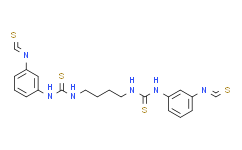| 中文名称: | 地夸磷索四钠 促销 | ||||
|---|---|---|---|---|---|
| 英文名称: | Diquafosol Tetrasodium | ||||
| 别名: | Diquafosol sodium;INS365 | ||||
| CAS No: | 211427-08-6 | 分子式: | C18H22N4Na4O23P4 | 分子量: | 878.23 |
| CAS No: | 211427-08-6 | ||||
| 分子式: | C18H22N4Na4O23P4 | ||||
| 分子量: | 878.23 | ||||
包装规格:
2mg 5mg 10mg 25mg 50mg 100mg in glass bottle
溶解性:
DMSO :1 mg/mL (1.14 mM; Need ultrasonic)
Water:100 mg/mL (113.87 mM; Need ultrasonic)
Water:100 mg/mL (113.87 mM; Need ultrasonic)
储备液保存:
-80°C, 6 months
-20°C, 1 month
(sealed storage, away from moisture)
-20°C, 1 month
(sealed storage, away from moisture)
体内实验:
1、请依序添加每种溶剂: PBS
Solubility: 100 mg/mL (113.87 mM); Clear solution; Need ultrasonic
<1mg/ml表示微溶或不溶。
普西唐提供的所有化合物浓度为内部测试所得,实际溶液度可能与公布值有所偏差,属于正常的批间细微差异现象。
请根据产品在不同溶剂中的溶解度选择合适的溶剂配制储备液;一旦配成溶液,请分装保存,避免反复冻融造成的产品失效。
Solubility: 100 mg/mL (113.87 mM); Clear solution; Need ultrasonic
<1mg/ml表示微溶或不溶。
普西唐提供的所有化合物浓度为内部测试所得,实际溶液度可能与公布值有所偏差,属于正常的批间细微差异现象。
请根据产品在不同溶剂中的溶解度选择合适的溶剂配制储备液;一旦配成溶液,请分装保存,避免反复冻融造成的产品失效。
靶点:
P2Y2 Receptor
体外研究:
Cell viability significantly decreased after treatment with 30% diluted diquafosol for 1 hour and 6 hours after treatment with 10% and 20% diluted diquafosol. Twenty-four hours after wounding monolayers, 3% diquafosol, and 0.3% HCECs exhibits significantly more wound healing than the control.
体内研究:
In a rat dry eye model, the P2Y2 agonist diquafosol tetrasodium is found to improve surface health, based on increases in tear fluid secretion, corneal epithelial resistance, and release of glycoprotein-containing moieties from goblet cells. Beginning at 2 weeks and continuing for an additional 2 weeks, maximal declines in dye penetrance of approximately 50% occurred with doses of diquafosol tetrasodium as low as 1%. INS365 significantly suppresses corneal damage at concentrations of more than 0.1% w/v.
产品特点:
Diquafosol tetrasodium 是一种P2Y2受体激动剂,可刺激眼睛表面的液体和粘蛋白分泌,用于干眼病的研究。
保存条件:
2-8°C 干燥密封
注意事项:
1、为了您的安全和健康,请穿实验服并戴一次性手套操作。
2、以上信息仅做参考交流之用。
2、以上信息仅做参考交流之用。
UN码:
HazardClass:
危害声明:
安全说明:
搜索质检报告(COA)
参考文献 & 客户发表文献
本计算器可帮助您计算出特定溶液中溶质的质量、溶液浓度和体积之间的关系,公式为:
质量 (g) = 浓度 (mol/L) x 体积 (L) x 分子量 (g/mol)
摩尔浓度计算公式
用本工具协助配置特定浓度的溶液,使用的计算公式为:
开始浓度 x 开始体积 = 最终浓度 x 最终体积
稀释公式
稀释公式一般简略地表示为:C1V1 = C2V2 ( 输入 输出 )








